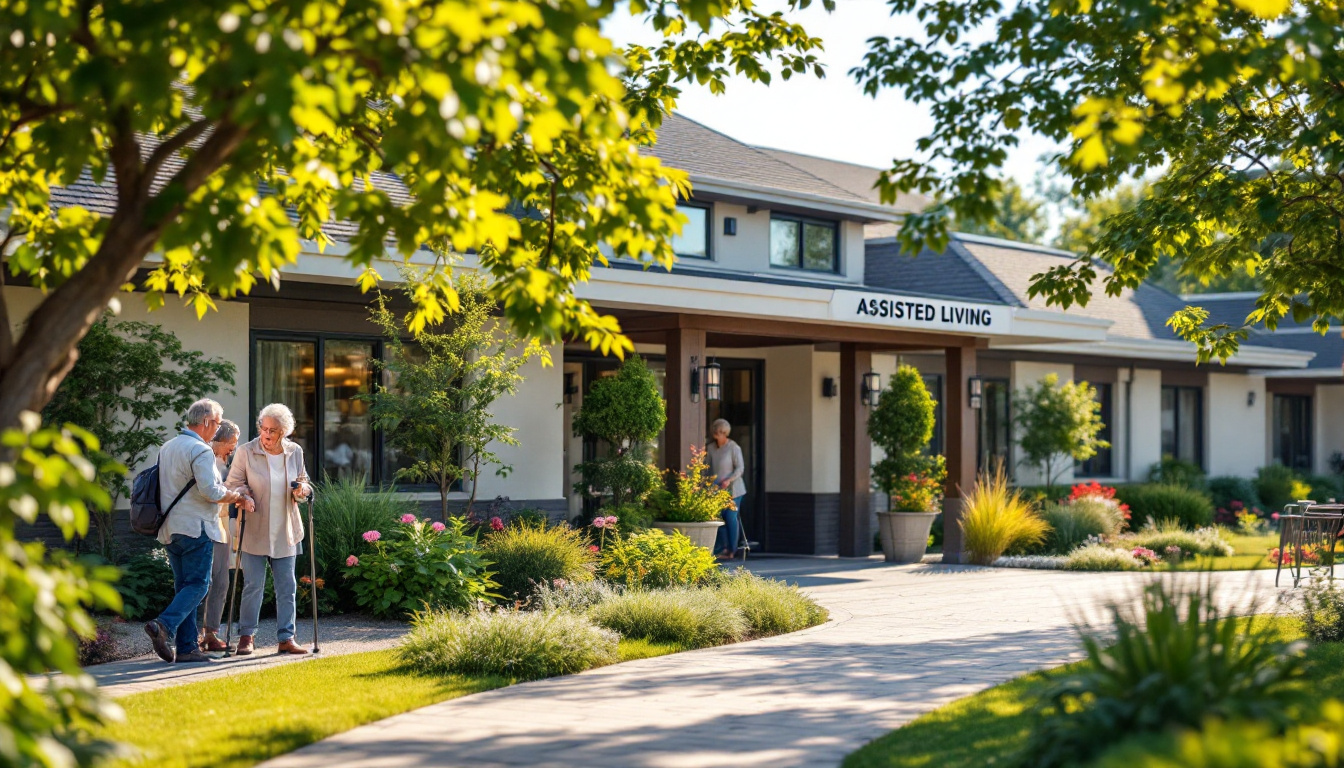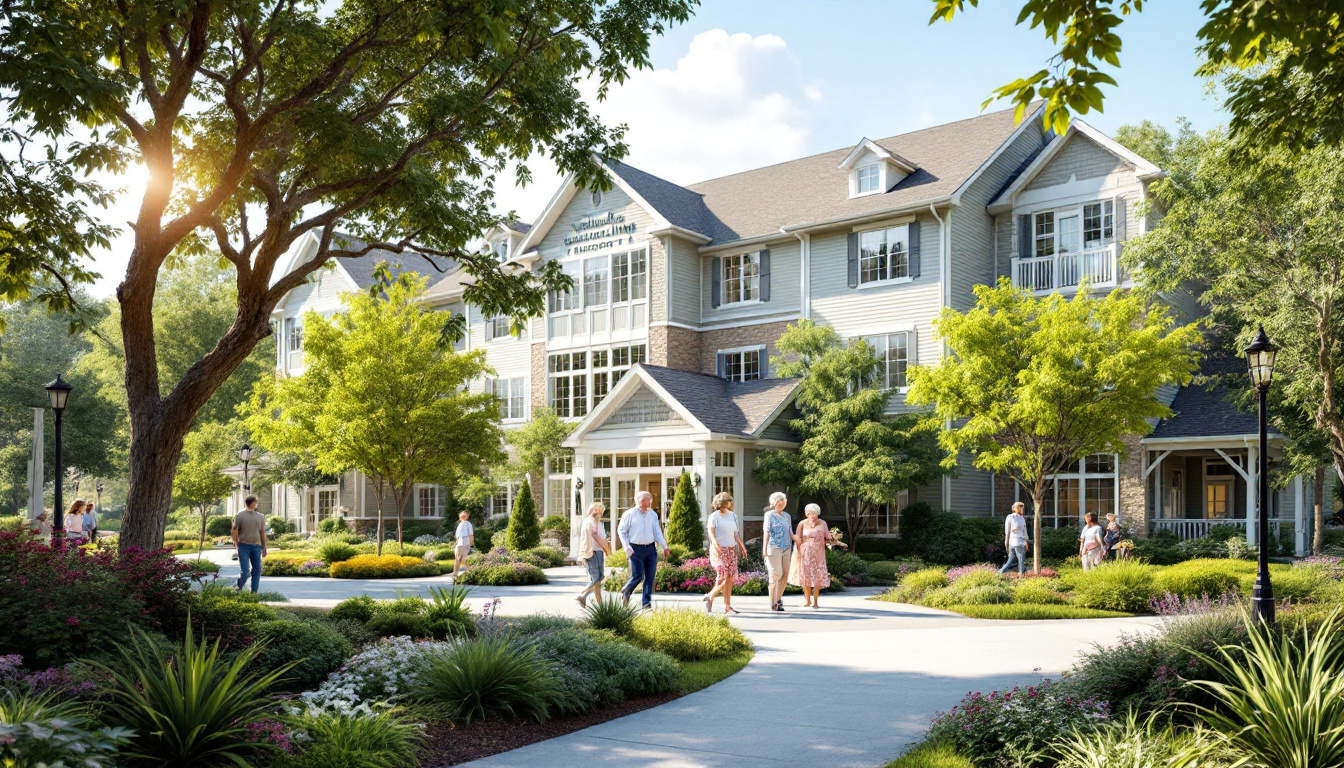How Assisted Living Facilities Help Seniors Transition from Hospital to Long-Term Care
Ensuring Safe and Seamless Post-Hospital Transitions for Seniors

The Critical Role of Assisted Living in Elder Care Transitions
Transitioning seniors from hospital to long-term care settings is a complex process that requires meticulous planning, effective communication, and personalized support. Assisted living facilities play a vital role in facilitating safe, dignified, and efficient transitions, ensuring that seniors receive appropriate care while maintaining their independence. This article explores how assisted living environments support recovery and ongoing care, the steps involved in care transitions, and best practices to improve outcomes.
Understanding When a Senior Needs Transition to Assisted Living or Long-Term Care

What are the signs indicating a senior may need to transition to assisted living or long-term care after hospitalization?
Recognizing the signs that a senior requires a move to assisted living or a long-term care facility is crucial for ensuring their safety and well-being. After hospitalization, several indicators can signal that the current living situation no longer meets their needs.
Physical changes such as worsening mobility, frequent falls, or difficulty performing activities of daily living (ADLs)—like bathing, dressing, or feeding—are significant red flags. Safety concerns within the home environment, including hazards like clutter, uneven flooring, or unsafe bathrooms, often necessitate a more supportive setting.
Cognitive decline is another critical factor. Memory issues, confusion, or behavioral changes such as social withdrawal and depression can impair a senior's ability to live independently. When these mental health changes coincide with increased medical needs, it might be time to consider assisted living or other supportive care options.
Caregiver challenges also play a role. The stress and burnout experienced by family members or unpaid caregivers, coupled with difficulties managing complex medication schedules or maintaining nutritional needs, suggest that more formal assistance could be beneficial.
Overall, a combination of health deterioration, safety risks, behavioral shifts, and caregiver strain indicates it may be appropriate to transition a senior into assisted living or long-term care to provide the necessary support and ensure their safety.
Differences Between Assisted Living and Skilled Nursing Facilities

What are the differences between assisted living and skilled nursing facilities?
Assisted living and skilled nursing facilities serve older adults' health and housing needs but differ significantly in their level of medical care, environment, and costs.
Assisted living mainly offers help with daily activities, such as bathing, dressing, medication management, and transportation. Residents typically live in their own private apartments or rooms, fostering an environment that feels more like a home. The setting focuses on promoting independence and social engagement, with amenities like communal dining, social activities, and personal care support.
In contrast, skilled nursing facilities (SNFs) provide round-the-clock medical supervision and intensive nursing care. They are equipped to manage complex health conditions, provide rehabilitation services, and handle medical interventions like IV therapy, respiratory treatments, or wound care. These facilities resemble hospitals, with shared or private rooms designed for longer stays involving more medical oversight.
Cost is a crucial factor in choosing between the two. Assisted living tends to be less expensive, with monthly costs averaging around $5,900, primarily paid out-of-pocket or through private sources. Skilled nursing services are more costly, often covered by Medicare or Medicaid, because of the extensive medical care provided.
Overall, the key difference lies in the level of medical support. Assisted living supports seniors in maintaining independence while managing daily needs, whereas skilled nursing ensures comprehensive medical treatment for those with complex health issues.
Benefits of Assisted Living for Post-Hospital Recovery

What are the benefits of choosing assisted living facilities for post-hospital recovery and long-term care?
Assisted living facilities provide a supportive and secure environment ideal for seniors recovering from hospital stays. These communities are designed to offer more than just basic housing; they include on-site therapeutic services such as physical, occupational, and speech therapies. These services are essential in helping seniors regain mobility, rebuild strength, and manage ongoing health issues.
Residents in assisted living typically live in their own apartments or private rooms, which promotes independence while still giving access to personalized care. Care plans are tailored to individual needs, ensuring that each resident receives the right level of assistance, whether it’s help with medication management, personal care, or mobility support.
Safety is a significant advantage. Assisted living centers are structured to reduce risks like falls or infections through features such as supervised activities, regular health monitoring, and immediate access to healthcare professionals. This close oversight helps prevent medical complications and ensures quick response when needs arise.
Moreover, these communities encourage social engagement and mental stimulation through organized activities, events, and opportunities to connect with peers. This social aspect plays a vital role in emotional well-being and helps combat feelings of isolation or depression that can occur during recovery.
When transitioning from hospital care, assisted living facilitates a smoother process. It supports seniors in maintaining their routines and fosters independence, making the recovery journey more effective and less stressful. Overall, assisted living centers aim to promote health, safety, and quality of life during the critical recovery phase and beyond.
| Aspect | Benefit | Additional Details |
|---|---|---|
| Safety | Reduces fall and infection risks | Supervision, monitoring, professional staff |
| Personalized Care | Tailored to individual needs | Care plans, medication, mobility support |
| Social Engagement | Maintains mental health | Events, activities, peer interactions |
| Continuity of Care | Facilitates smooth recovery | On-site therapy, coordinated healthcare |
Choosing assisted living for post-hospital recovery helps seniors regain independence while ensuring they are cared for in a safe, engaging environment that promotes overall well-being.
Effective Communication and Advocacy During Transfers

What strategies can families and caregivers use to effectively communicate and advocate during seniors' care transfers?
Family members and caregivers play a pivotal role in ensuring the safety and well-being of seniors during transitions between care settings. One of the most effective approaches is maintaining ongoing, clear communication with healthcare professionals involved in the transfer. Regular updates, asking detailed questions about the senior’s current medications, medical history, and care needs can help clarify expectations and prevent misunderstandings.
Using technological tools can significantly enhance communication. Electronic health records, secure messaging systems, and even personal health record binders empower families to access crucial information and stay informed. These resources also help in sharing comprehensive data with different providers, reducing the risk of incomplete or inaccurate transfer documentation.
Early involvement in planning is vital. Engaging families from the beginning allows them to contribute insights about the senior's preferences and daily routines, ensuring personalized care during and after the transfer. This participatory approach not only improves outcomes but also helps reduce anxiety for the senior.
Healthcare providers can implement structured communication methods such as SBAR (Situation, Background, Assessment, Recommendation). SBAR ensures essential information is conveyed systematically, promoting clarity and understanding among all parties involved.
Verifying that all transfer documents have been received and understood by the receiving team is another critical step. Proper documentation of all exchanges, including notes on medication lists, recent hospital events, and care plans, is imperative to prevent omissions that could compromise safety.
Education and training are fundamental. Both healthcare providers and families should be equipped with skills to communicate effectively, including cultural sensitivity and privacy rights. This fosters a respectful environment conducive to open dialogue, ultimately facilitating smoother, safer elder care transitions.
Steps in the Transition Process from Hospital to Long-Term Care

What are the steps involved in the process of senior care transitions from hospital to assisted living or nursing facilities?
Transitioning a senior from hospital to a long-term care setting involves several carefully planned steps to ensure their safety, comfort, and well-being.
The process begins with comprehensive discharge planning, which should start early during the hospital stay. Healthcare providers evaluate the senior's medical condition, functional abilities, and personal preferences to develop a tailored care plan. This plan covers medication management, necessary medical treatments, and safety considerations.
Selecting an appropriate facility is a critical phase. Families and caregivers need to research options thoroughly, considering the level of medical support available, capacity, location, and amenities. Touring prospective communities allows families to observe cleanliness, staff engagement, resident interactions, and available activities. Asking detailed questions—such as about admission policies, costs, and services—helps families make informed choices.
Accurate and complete documentation is essential for a smooth transfer. This includes detailed medical records, medication lists, and functional assessments. Effective communication between hospital staff and the chosen facility prevents errors and ensures continuity of care.
Preparing the senior physically and emotionally is equally important. Home modifications, if returning home, can reduce fall risks. Providing emotional support, involving mental health professionals if needed, and gradually introducing the senior to their new environment help ease anxiety and promote adaptation.
Family caregivers play a vital role in this process. Their involvement includes asking detailed questions, sharing relevant hospital information, and advocating for the senior’s needs. Continuous follow-up after the move maintains engagement and addresses any emerging issues.
Overall, successful transitions depend on coordinated efforts, clear communication, and active participation from healthcare teams, families, and the seniors themselves. This comprehensive approach promotes safety, preserves dignity, and supports optimal health outcomes.
Navigating the Transition from Assisted Living to Other Care Settings
 The process of shifting from assisted living to a nursing home or more intensive care environment requires thorough assessment and planning. Families should begin by evaluating the senior’s medical needs, such as the necessity for around-the-clock medical attention, feeding assistance, or mobility support. Consulting healthcare professionals, including primary care physicians and specialists, helps determine whether a higher level of care is appropriate based on the resident’s health status.
The process of shifting from assisted living to a nursing home or more intensive care environment requires thorough assessment and planning. Families should begin by evaluating the senior’s medical needs, such as the necessity for around-the-clock medical attention, feeding assistance, or mobility support. Consulting healthcare professionals, including primary care physicians and specialists, helps determine whether a higher level of care is appropriate based on the resident’s health status.
Regular evaluations are vital for detecting changes in mobility, cognitive function, or overall health that might signal it’s time to consider a move. Increased hospital visits, complications from chronic illnesses, or declining ability to perform daily activities often indicate that a transition to a nursing home may be necessary.
Research is equally important. Families should visit multiple facilities to assess their suitability, paying attention to cleanliness, staff interactions, resident comfort, and available medical services. Involving the senior in the decision-making process respects their autonomy and ensures their preferences are considered, which can ease emotional stress.
To make the transition smoother, start organizing and transferring medical records, care plans, and medication lists well in advance. Preparing the senior emotionally includes providing reassurance, involving them in choosing personal items for their new space, and offering familiar comforts.
Continued family involvement, emotional support, and attention to the senior’s mental well-being are crucial during the adjustment period. Support from caregivers and loved ones can make a significant difference in helping seniors feel more secure and accepted in their new environment. Overall, careful assessment, proactive communication, and compassionate support play essential roles in navigating this change successfully.
Ensuring Safety, Continuity, and Quality of Care in Transitions

How do assisted living facilities ensure safety, continuity, and quality care during transitions?
Assisted living facilities play a crucial role in safeguarding seniors during sensitive periods like hospital discharges or moving into new environments. They achieve this by establishing well-defined protocols that focus on personalized, attentive care. Staff members are specially trained to handle emergencies, medication management, and daily support tasks, ensuring that residents receive consistent and proper care.
Open and effective communication is at the heart of a smooth transition. Facilities maintain regular, transparent interactions with residents, families, and healthcare providers. This includes sharing vital medical information, updating care plans, and discussing any concerns proactively. Such communication helps prevent errors, like medication mistakes, and ensures everyone is aligned on the resident’s needs.
To further enhance safety and quality, many assisted living communities participate in Patient Safety Organizations (PSOs). These groups gather data on incidents such as falls, medication errors, or safety violations, analyze root causes, and develop strategies for improvement. Through continuous monitoring and feedback, facilities foster a culture committed to learning and safety.
Staff training is also fundamental. Regular education on emergency procedures, care protocols, and resident rights arms caregivers with the skills needed to respond ethically and efficiently. This training ensures that residents are protected and that any adverse incidents are swiftly managed.
Many facilities adopt comprehensive quality improvement programs, like the recognition by the National Quality Award Program, which encourages adherence to best practices. These programs focus on improving resident health outcomes, satisfaction, and safety.
Personalized approaches further support safe transitions. Staff members help residents become familiar with their new environment, advocate for individual preferences, and conduct regular check-ins. This ongoing engagement helps residents feel secure, respected, and valued, reducing anxiety and the risk of complications.
In conclusion, by combining standardized safety protocols, ongoing staff education, robust communication, and quality improvement initiatives, assisted living facilities ensure that seniors experience safe, seamless, and high-quality care during their transitions.
Supporting Seniors in Transition from Hospital to Long-Term Care

How do assisted living facilities support seniors transitioning from hospital to long-term care?
Assisted living communities play a vital role in helping seniors move smoothly from hospital stays to long-term residence. They develop tailored care plans that reflect each individual's health status, personal preferences, and needs, ensuring a personalized approach.
These facilities actively coordinate with healthcare providers to manage medications, monitor health conditions, and facilitate follow-ups. Additionally, they help connect families with community services and resources, such as those found on PAHousingSearch.com, which assist in locating accessible, safe, and suitable housing options.
Preparing for a move involves understanding what modifications are necessary at home, such as installing grab bars or removing tripping hazards, to promote safety and independence. Assisted living staff often guide families through the administrative aspects of relocation, including completing necessary documentation and assessing eligibility for programs like the Nursing Home Transition (NHT) program.
The NHT program specifically supports individuals in transitioning back to community settings from nursing facilities, emphasizing the importance of person-centered care and safe discharge planning.
Overall, assisted living facilities focus on creating a seamless, supportive process that not only addresses medical and physical needs but also considers emotional well-being. They strive to make the transition less stressful and more affirming so that seniors can enjoy a better quality of life in their new homes.
The Role of Resources and Best Practices in Facilitating Transitions

Are there best practices and resources available to assist seniors in transitioning from hospital to long-term residential care?
Yes, numerous strategies, tools, and community support systems are in place to help older adults make smooth and safe transitions from hospital to long-term care settings. Effective discharge planning starts early, involving clear communication among healthcare providers, patients, and their families.
Multidisciplinary teams—including doctors, nurses, social workers, and care coordinators—collaborate to prepare the senior for their next care environment. They use structured frameworks such as the 4Ms—Matters, Medications, Mentation, and Mobility—to guide comprehensive care planning.
Practical tools like medication reconciliation sheets, care transition checklists, and teach-back methods ensure that seniors and their caregivers understand post-discharge instructions. These resources help prevent common issues like medication errors and communication gaps.
Community organizations such as Area Agencies on Aging and USAging support seniors through case management, transportation services, in-home care, and assistive technology solutions tailored to individual needs.
Technology plays a vital role; electronic health records enable real-time sharing of medical history and recent hospital events, reducing the risk of missing critical information. Telemonitoring and mobile health apps also help track important health data remotely, providing added safety checks.
Evidence-based models like the Care Transitions Intervention and the Transitional Care Model focus on patient education, medication management, and regular follow-up calls. These structured approaches have been shown to decrease hospital readmissions and promote better recovery.
In summary, combining best practice guidelines, robust community resources, and innovative technology tools creates a comprehensive support system that improves safety, functional outcomes, and quality of life for seniors during their care transitions.
Enhancing Elder Care Transitions for Better Outcomes
Effective support during the transition from hospital to long-term care is essential to safeguard seniors’ health, dignity, and quality of life. Assisted living facilities serve as a cornerstone in this process, providing tailored, safe, and supportive environments that address the complex needs of aging adults. Through thorough discharge planning, clear communication, community engagement, and continuous quality improvement, healthcare providers, families, and care facilities can ensure seamless and safe transitions. Emphasizing person-centered approaches and utilizing available resources and best practices, we can minimize risks, enhance recovery, and promote elder well-being in the crucial post-hospital phase.
References
- Long-Term Care Facilities: Assisted Living, Nursing Homes, and ...
- Transferring Older Adults from Hospitals to Nursing Homes
- How to Help Seniors Transition Back Home After Hospitalization
- Supporting the Transition From Hospital to Home for Older Adults
- How to Transition Your Loved One From the Hospital to Assisted ...
- The Physician's Role in Transitioning Older Adults Into Long-term ...
- Move from Assisted Living to Nursing Home - A Place for Mom






































































































